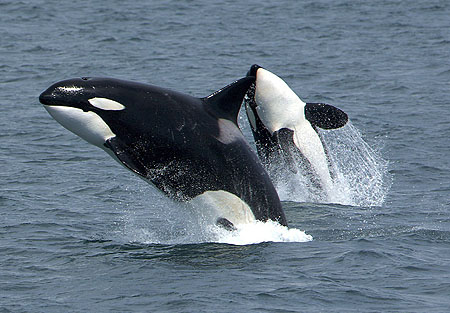 Killer whales. Photo by Pittman, courtesy NOAA, via Wikimedia Commons.
Killer whales. Photo by Pittman, courtesy NOAA, via Wikimedia Commons.
A new paper in Conservation Letters calculates that the numbers of whales and dolphins killed in BP’s Deepwater Horizon disaster could be 50 times higher than the number of carcasses found.
The authors—a high-powered list of renowned cetacean researchers from Canada, the US, Australia, and Scotland (including Scott Krause, who I filmed years ago for a documentary about North Atlantic right whales)—write of a general misperception of the Deepwater Horizon impact:
Many media reports have suggested that the spill caused only modest environmental impacts, in part because of a low number of observed wildlife mortalities, especially marine mammals.
 Atlantic spotted dolphins. Photo by Bmatulis, via Wikimedia Commons.
Atlantic spotted dolphins. Photo by Bmatulis, via Wikimedia Commons.
Compared to the 1989 Exxon Valdez, with its iconic oiled otters and high body counts, the Deepwater Horizon seems, well, not so bad. The authors point out that “only” 101 dead cetaceans (whales, dolphins, and porpoises) were found in the Northern Gulf of Mexico as of 7 November 2010. The number’s misleading though.
The issue arises when policymakers, legislators, or biologists treat these carcass-recovery counts as though they were complete counts or parameters estimated from some representative sample, when in fact, they are opportunistic observations. Our study suggests that these opportunistic observations should be taken to estimate only the bare minimum number of human-caused mortalities.
 Humpback whale. Photo by Whit Welles Wwelles14, via Wikimedia Commons.
Humpback whale. Photo by Whit Welles Wwelles14, via Wikimedia Commons.
So how many more whales, dolphins, and porpoises actually died? That problem is tough to figure to begin with and is compounded by a dearth of data in the Gulf—a fact that will work greatly in BP’s favor when the time comes to levy fines.
The Gulf of Mexico is a semi-enclosed subtropical sea that forms essentially one ecosystem with many demographically independent cetacean populations. Some of these cetacean populations, such as killer whales (Orcinus orca), false killer whales (Pseudorca crassidens), melonheaded whales (Peponocephala electra), and several beaked whale species, appear to be quite small, are poorly studied, or are found in the pelagic realm where they could have been exposed to oil and yet never strand. Small, genetically isolated populations of bottlenose dolphins (Tursiops truncatus) could have experienced substantial losses either inshore or offshore.
 Atlantic spotted dolphins. Photo by Bmatulis, via Wikimedia Commons.
Atlantic spotted dolphins. Photo by Bmatulis, via Wikimedia Commons.
Two methods of extrapolation could shed light on how many cetaceans BP’s disaster killed:
- Compare abundance before the disaster to abundance after—but since we don’t know the population size of whale and dolphins species in the Gulf before hand we’re unlikely to notice anything short of “the most catastrophic decline” and maybe not even that.
- Count the number of carcasses recovered—knowing that many will evade our count, having sunk, decayed, been scavenged, or drifted away. So adjust the counts upward to estimate total mortality. This approach is used to estimate bird deaths at power lines, where, in at least one instance, we now know that bird body counts underestimate total actual deaths by a whopping 32 percent.
The authors worked the two methods as best they could and added something more.
Given the magnitude of the spill and complexity of the response, quantifying the ecological impacts will take a long time. To contribute to this effort, we examined historical data from the Northern Gulf of Mexico to evaluate whether cetacean carcass counts in this region have previously been reliable indicators of mortality, and may therefore accurately represent deaths caused by the Deepwater Horizon/BP event.
 Sperm whale. Photo courtesy NOAA, via Wikimedia Commons.
Sperm whale. Photo courtesy NOAA, via Wikimedia Commons.
Their methods and analysis suggest that an average of 4,474 cetaceans died in the northern Gulf every year between 2003 and 2007 from all causes, human and natural. Yet since an average of only 17 bodies were found in those years, the body count represented only ~0.4 percent of total deaths.
Consider, for example, one sperm whale being detected as a carcass, and a necropsy identi?ed oiling as a contributing factor in the whale’s death. If the carcass-detection rate for sperm whales is 3.4%, then it is plausible that 29 sperm whale deaths represents the best estimate of total mortality, given no additional information. If, for example, 101 cetacean carcasses were recovered overall, and all deaths were attributed to oiling, the average-recovery rate (2%) would translate to 5,050 carcasses, given the 101 carcasses detected.
Those are chilling numbers. Period. But also in light of the relatively tiny populations of cetaceans in the Gulf. Especially since most if not all cetaceans are highly social, and since oil and chemical dispersants likely injured, sickened, or killed entire clusters, schools, pods, matrilines, or groups at the same time—and may still be doing so.
The authors describe the near-lethal affect of the Exxon Valdez disaster on one well-known and well-studied pod of killer whales in Alaska.
In the ?rst year after the 1989 Exxon Valdez spill, the AT1 group of “transient” killer whales experienced a 41% loss; there has been no reproduction since the spill. Although the cause of the apparent sterility is unknown, the lesson serves as an important reminder that immediate death is not the only factor that can lead to long-term loss of population viability.
 Pilot whale mother and calf. Photo by Clark Anderson via Wikimedia Commons.
Pilot whale mother and calf. Photo by Clark Anderson via Wikimedia Commons.
The paper:
- Williams. R, Gero. S, Bejder. L., Calambokidis. J, Kraus. S, Lusseau. D, Read. A, Robbins. J. Underestimating the Damage: Interpreting Cetacean Carcass Recoveries in the Context of the Deepwater Horizon/BP Incident. Conservation Letters. Wiley-Blackwell. March 2011, DOI: 10.1111/j.1755-263X.2011.00168.x
Crossposted from Deep Blue Home.







